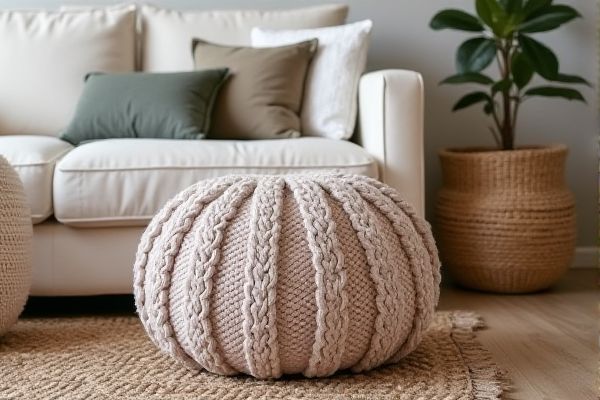
Knitted poufs offer a soft, textured surface with intricate patterns that add a cozy, handcrafted feel to your living space, while braided poufs provide a sturdy, woven design that delivers durability and a rustic charm. Explore the rest of the article to discover which pouf best suits your style and functional needs.
Table of Comparison
| Feature | Knitted Pouf | Braided Pouf |
|---|---|---|
| Material | Soft yarn, cotton, or wool | Thick braided cotton or jute rope |
| Texture | Smooth, stretchy with knit patterns | Rougher, textured with braided design |
| Durability | Moderate, best for indoor use | High, suitable for indoor and outdoor |
| Design Style | Modern, cozy, minimalist | Rustic, natural, bohemian |
| Maintenance | Hand wash or gentle machine wash | Spot clean with mild detergent |
| Comfort Level | Soft and cushy | Firm and supportive |
| Weight Capacity | Up to 150 lbs (68 kg) | Up to 200 lbs (90 kg) |
| Price Range | Affordable to mid-range | Mid-range to premium |
Introduction to Poufs: Knitted vs Braided
Knitted poufs feature tightly woven yarns creating a smooth, cozy texture ideal for modern and minimalist interiors, while braided poufs consist of interlaced strips offering a rustic, artisanal look with enhanced durability. Your choice between knitted and braided poufs depends on the desired aesthetic and functional use, as knitted poufs provide softness, whereas braided poufs offer structural firmness. Both types serve as versatile furniture pieces for seating or decor, blending comfort with style in living spaces.
Material Composition: Knitted vs Braided Poufs
Knitted poufs are typically crafted from soft, chunky yarns such as cotton, wool, or acrylic, providing a plush and cozy texture ideal for adding warmth to living spaces. Braided poufs often incorporate durable materials like jute, leather, or tightly woven fabric strips, offering a structured and resilient surface suited for high-traffic areas. Your choice between knitted and braided poufs should consider the material composition's impact on comfort, durability, and aesthetic appeal.
Design Aesthetics: Comparing Styles and Patterns
Knitted poufs feature intricate, textured patterns with chunky yarns that add warmth and a cozy, handcrafted feel to interiors. Braided poufs showcase tightly woven designs with smooth, continuous strands, offering a sleek and contemporary look with geometric precision. Both styles enhance design aesthetics through unique patterns, but knitted poufs evoke softness while braided poufs present a structured elegance.
Durability and Longevity
Knitted poufs made from tightly woven yarns tend to offer excellent durability and maintain their shape well over time, resisting wear and tear in high-traffic areas. Braided poufs, constructed with interlaced fibers, provide strong structural integrity and often exhibit greater resistance to stretching and fraying. Your choice should consider the specific material quality and knitting or braiding technique, as these factors significantly impact the longevity of the pouf.
Comfort and Functionality
Knitted poufs offer a soft, cushioned surface with dense yarn that provides excellent comfort for seating and footrests, making them ideal for cozy indoor use. Braided poufs feature a sturdier texture with interwoven strands, delivering enhanced durability and structural support suitable for higher weight and frequent use. Both types function well as versatile accent pieces, but knitted poufs prioritize plush comfort while braided poufs emphasize long-lasting functionality.
Maintenance and Cleaning
Knitted poufs often require gentle hand washing or spot cleaning with mild detergent to maintain their softness and prevent fiber damage, while braided poufs benefit from more robust cleaning methods such as vacuuming and wiping due to their durable material. Your knitted pouf's delicate construction demands careful care to avoid stretching or snagging, whereas braided poufs generally resist stains and wear, making maintenance simpler and more durable in high-traffic areas. Regular upkeep tailored to each type will extend the lifespan and appearance of your chosen pouf.
Versatility in Home Decor
Knitted poufs offer a cozy, textured aesthetic perfect for casual, bohemian, or Scandinavian inspired interiors, while braided poufs bring a structured, artisanal charm suitable for eclectic and contemporary settings. Your choice between knitted and braided poufs can enhance seating flexibility, serve as footrests, or act as decorative accents, making either option highly versatile in living rooms, bedrooms, or lounges. The tactile appeal and durability of these poufs contribute to their multifunctional use, allowing seamless integration into various home decor styles.
Price Comparison
Knitted poufs typically range from $40 to $100 depending on size, materials, and brand, offering affordable options for budget-conscious buyers. Braided poufs generally command a higher price, averaging between $80 and $150 due to their intricate weaving and durable construction. The price difference reflects the craftsmanship level, with braided poufs often considered an investment piece in home decor.
Pros and Cons of Knitted Poufs
Knitted poufs offer a cozy, textured look that adds warmth and softness to any space, making them perfect for creating a relaxed atmosphere. Their lightweight nature makes them easy to move around, but they may be less durable and harder to clean compared to braided poufs, which often provide more robustness and resilience. Your choice depends on whether you prioritize aesthetic comfort or long-lasting functionality.
Pros and Cons of Braided Poufs
Braided poufs offer a durable and textured design, often made with thick, interwoven fabric or rope that provides enhanced sturdiness and a rustic aesthetic. They tend to be heavier and more stable compared to knitted poufs, making them ideal for high-traffic areas, but their denser materials can reduce breathability and comfort for extended seating. Braided poufs also require minimal maintenance, resisting wear and tear better than knitted alternatives, though they generally lack the softness and flexibility that knitted poufs provide.
 homyna.com
homyna.com